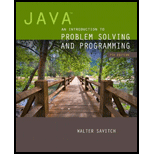
The Fibonacci sequence occurs frequently in nature as the growth rate for certain idealized animal populations. The sequence begins with 0 and 1, and each successive Fibonacci number is the sum of the two previous Fibonacci numbers. Hence, the first ten Fibonacci numbers are 0, 1, 1, 2, 3, 5, 8, 13, 21, and 34. The third number in the series is 0 + 1, which is 1; the fourth number is 1 + 1, which is 2; the fifth number is 1 + 2, which is 3; and so on.
Besides describing population growth, the sequence can be used to define the form of a spiral. In addition, the ratios of successive Fibonacci numbers in the sequence approach a constant, approximately 1.618, called the “golden mean”. Humans find this ratio so aesthetically pleasing that it is often used to select the length and width rations of rooms and postcards.
Use a recursive formula to define a static method to compute the nth Fibonacci number, given n as an argument. Your method should not use a loop to compute all the Fibonacci numbers up to the desired one, but should be a simple recursive method. Place this static recursive method in a
Fibonacci #1 = 0
Fibonacci #2 = 1
Fibonacci #3 = 1; 1/1 = 1
Fibonacci #4 = 2; 2/1 = 2
Fibonacci #5 = 3; 3/2 = 1.5
Want to see the full answer?
Check out a sample textbook solution
Chapter 11 Solutions
Java: An Introduction to Problem Solving and Programming (7th Edition)
Additional Engineering Textbook Solutions
Starting Out with Java: From Control Structures through Objects (7th Edition) (What's New in Computer Science)
Starting Out with Python (4th Edition)
INTERNATIONAL EDITION---Engineering Mechanics: Statics, 14th edition (SI unit)
Introduction To Programming Using Visual Basic (11th Edition)
Web Development and Design Foundations with HTML5 (8th Edition)
Elementary Surveying: An Introduction To Geomatics (15th Edition)
- For this question you will perform two levels of quicksort on an array containing these numbers: 59 41 61 73 43 57 50 13 96 88 42 77 27 95 32 89 In the first blank, enter the array contents after the top level partition. In the second blank, enter the array contents after one more partition of the left-hand subarray resulting from the first partition. In the third blank, enter the array contents after one more partition of the right-hand subarray resulting from the first partition. Print the numbers with a single space between them. Use the algorithm we covered in class, in which the first element of the subarray is the partition value. Question 1 options: Blank # 1 Blank # 2 Blank # 3arrow_forward1. Transform the E-R diagram into a set of relations. Country_of Agent ID Agent H Holds Is_Reponsible_for Consignment Number $ Value May Contain Consignment Transports Container Destination Ф R Goes Off Container Number Size Vessel Voyage Registry Vessel ID Voyage_ID Tonnagearrow_forwardI want to solve 13.2 using matlab please helparrow_forward
- a) Show a possible trace of the OSPF algorithm for computing the routing table in Router 2 forthis network.b) Show the messages used by RIP to compute routing tables.arrow_forwardusing r language to answer question 4 Question 4: Obtain a 95% standard normal bootstrap confidence interval, a 95% basic bootstrap confidence interval, and a percentile confidence interval for the ρb12 in Question 3.arrow_forwardusing r language to answer question 4. Question 4: Obtain a 95% standard normal bootstrap confidence interval, a 95% basic bootstrap confidence interval, and a percentile confidence interval for the ρb12 in Question 3.arrow_forward
 C++ for Engineers and ScientistsComputer ScienceISBN:9781133187844Author:Bronson, Gary J.Publisher:Course Technology Ptr
C++ for Engineers and ScientistsComputer ScienceISBN:9781133187844Author:Bronson, Gary J.Publisher:Course Technology Ptr C++ Programming: From Problem Analysis to Program...Computer ScienceISBN:9781337102087Author:D. S. MalikPublisher:Cengage Learning
C++ Programming: From Problem Analysis to Program...Computer ScienceISBN:9781337102087Author:D. S. MalikPublisher:Cengage Learning EBK JAVA PROGRAMMINGComputer ScienceISBN:9781337671385Author:FARRELLPublisher:CENGAGE LEARNING - CONSIGNMENT
EBK JAVA PROGRAMMINGComputer ScienceISBN:9781337671385Author:FARRELLPublisher:CENGAGE LEARNING - CONSIGNMENT- Np Ms Office 365/Excel 2016 I NtermedComputer ScienceISBN:9781337508841Author:CareyPublisher:CengageProgramming Logic & Design ComprehensiveComputer ScienceISBN:9781337669405Author:FARRELLPublisher:Cengage
 Systems ArchitectureComputer ScienceISBN:9781305080195Author:Stephen D. BurdPublisher:Cengage Learning
Systems ArchitectureComputer ScienceISBN:9781305080195Author:Stephen D. BurdPublisher:Cengage Learning





